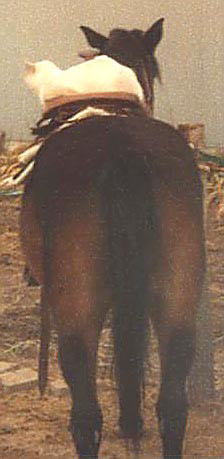Sandia's Foals
|
By June of 1992, we had about a dozen goats. Some horses really
like goats. They caper with each other and take turns watching
for predators. We also had chickens, dogs and cats. Some horses
like those sorts of critters, too, enjoying having them ride
and nap on their backs.
Coquetta didn't like goats. She ignored the chickens. Our
Siamese cat kept on jumping on her back and riding around on
her. The way she put her ears back made it clear that she disapproved,
but was just too ploite to buck him off.
Coquetta actively hated dogs. In particular, our Border Collie
Joe Kid was determined to learn how to herd a horse. Coquetta
was determined to turn her into sausage. Jo Kid always cheated
those flashing hooves. Coquetta always figured where Joe Kid
was trying to move her, and wenbt somewhere else. |

Coquetta with White Knight, the Siamese, on her back. |
When Coquetta wasn't trying to nail Jo Kid, she mostly stood
in the southeast corner of her pasture watching Arlene's Blue
and Ginger on a rise a quarter mile beyond. Sometimes they whinnied
to each other.
June 7, 1992, during Sunday school, our church phone rang.
It was Al Miller, and he was looking for me.
"Would you like to buy my colt," he asked. He explained
that the owner of the ranch he managed had said he could only
keep two of his horses there. He had to sell his yearling colt
quickly.After Sunday school, Virginia and I went over to where
a friend was keeping Al's colt. Al and his wife, Mary, met us
there. He pointed out a sorrel whom he said was ¾ Arabian
and ¼ Quarter Horse. At 16 months, he was already taller
than many grown horses. He had a blaze on his face and white
stockings on all legs. His face was beautiful, with big eyes,
bulging forehead, dished face and delicate muzzle.
The colt also was covered with scrapes. Al said the colt had
gotten into a fight with the other ranch horses.
This was only part of the colt's problem. His belly was bloated,
with parasites, I guessed. He was cow-hocked (crooked hind legs)
and had weak pasterns (the "ankle" part just above
the hoof).
More --->>

